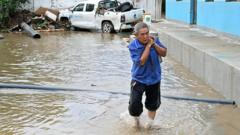In a tragic turn of events, over 30 elderly residents lost their lives this week when a sudden flood inundated a nursing home in the Miyun District, on the outskirts of Beijing. According to local officials, 31 fatalities were reported among the 77 residents who were trapped as rising waters reached nearly 2 meters (6 feet). Emergency response teams were seen navigating through chest-high floodwaters in desperate attempts to rescue those in peril. Many victims were reportedly immobile or severely disabled, compounding the tragedy.
This catastrophic incident has led local authorities to admit that there were serious "loopholes in emergency planning". A Chinese official commented that the area surrounding the facility had long been designated as safe, which explains why it was not included in the evacuation protocols. They described this calamity as a "painful lesson" and a significant "wake-up call" for the importance of adequate emergency preparations in the face of climate change and increasingly severe weather.
The broader impact of the flooding in and around Beijing has been considerable, with a total of 44 lives lost across the city as well as nearby Hebei Province. Recent reports indicated that 16 individuals died from extreme rainfall in Hebei, with some still unaccounted for. This year's flooding has affected vast areas of China, compounded by earlier heatwaves and typhoons that have resulted in additional fatalities.
Beijing experiences seasonal floods; one of the most devastating events occurred in July 2012 with 190mm of rain falling in a single day, resulting in 79 deaths. The current summer has seen catastrophic flooding costs reach approximately 54.11 billion yuan ($7.5 billion), mainly attributed to extreme weather events. Officials have warned that these natural disasters will continue to challenge China's economy and its vulnerable agricultural sector in the wake of climate change.



















